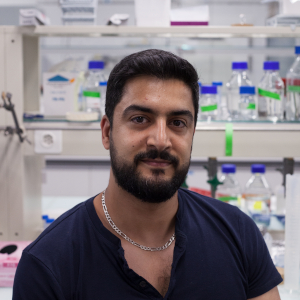 |
| Post Doc. U177/U176 abbas.abouhamdan@unibe.ch |
Characterisation of the Escherichia coli cytochrome b561 superoxide:ubiquinone oxidoreductase
Background
Since 2.4 billion years ago, O2 production started due to cyanobacteria as a product of oxygenic photosynthesis.[1] This appearance leads to the formation of Reactive Oxygen Species ‘ROS’, natural byproduct of O2 metabolism. Depending on their concentrations in living organisms, ROS could play an important role as signaling messengers[2] at low concentration or, in contrast, damage various cellular components such as proteins, lipids and nucleic acid at high concentration.[3]
Biologically, the superoxide anion radical O2-., ROS precursor, is produced during aerobic metabolism in mitochondria and prokaryotes or by phagocytic nicotinamide adenine dinucleotide phosphate oxidase (NADPH oxidase) as a crucial component of the immune system.[4] A dynamic balance is thus important to maintain superoxide anion level in the beneficial range to avoid ROS toxicity. Soluble enzymes such as superoxide dismutase and superoxide reductase are part of antioxidant systems in living cells exposed to oxygen. They catalyze disproportion or the reduction of superoxide anion radical into hydrogen peroxide respectively.[5] Recently, a membrane ‘cytochrome b561’ of E. coli has been characterized and its structure determined.[6] This enzyme has been qualified as a superoxide ubiquinone oxidoreductase ‘SOO’, constituting a third uncommon type of superoxide scavenging enzyme. It couples the oxidation of superoxide anion radical to the reduction of ubiquinone thus participating in electrochemical potential generation.
Project
The aim of the project is to characterize SOO either in detergent solubilized form or after reconstitution into liposomes. I am particularly interested in the determination of amino acids allowing ubiquinone binding and in the deciphering of the catalytic mechanism combining various techniques of biochemistry and biophysics.
References
- Canfield, D. E.; Rosing, M. T.; Bjerrum, C. Phil. Trans. R. Soc., B 2006, 361, 1819
- Sullivan, M. N. et al. Localized TRPA1 channel Ca2+ signals stimulated by reactive oxygen species promote cerebral artery dilation. Sci. Signal. 8, ra2 (2015).
- Araki, T.; Kitaoka, H. The Mechanism of Reaction of Ebselen with Superoxide in Aprotic Solvents as Examined by Cyclic Voltammetry and ESR. Chem. Pharm. Bull. 2001, 49, 541−545.
- Su, J.; Groves, J. T. Mechanisms of Peroxynitrite Interactions with Heme Proteins. Inorg. Chem. 2010, 49, 6317−6329.
- Sheng, Y.; Abreu, I. A.; Cabelli, D. E.; Maroney, M. J.; Miller, A.-F.; Teixeira, M.; Valentine, J. S. Superoxide Dismutases and Superoxide Reductases. Chem. Rev. 2014, 114, 3854−3918.
- Lundgren, C. A. K. et al. Scavenging of superoxide by a membrane-bound superoxide oxidase. Nat. Chem. Biol. 14, 788–793 (2018)
Publications
Abou-Hamdan A., Mahler R., Grossenbacher P., Biner O., Sjöstrand D., Lochner M., Högbom M., von Ballmoos C. (2022) Functional design of bacterial superoxide:quinone oxidoreductase. BBA. 2022 Jun, doi: 10.1016/j.bbabio.2022.148583. Epub ahead of print. PMID: 35671795.